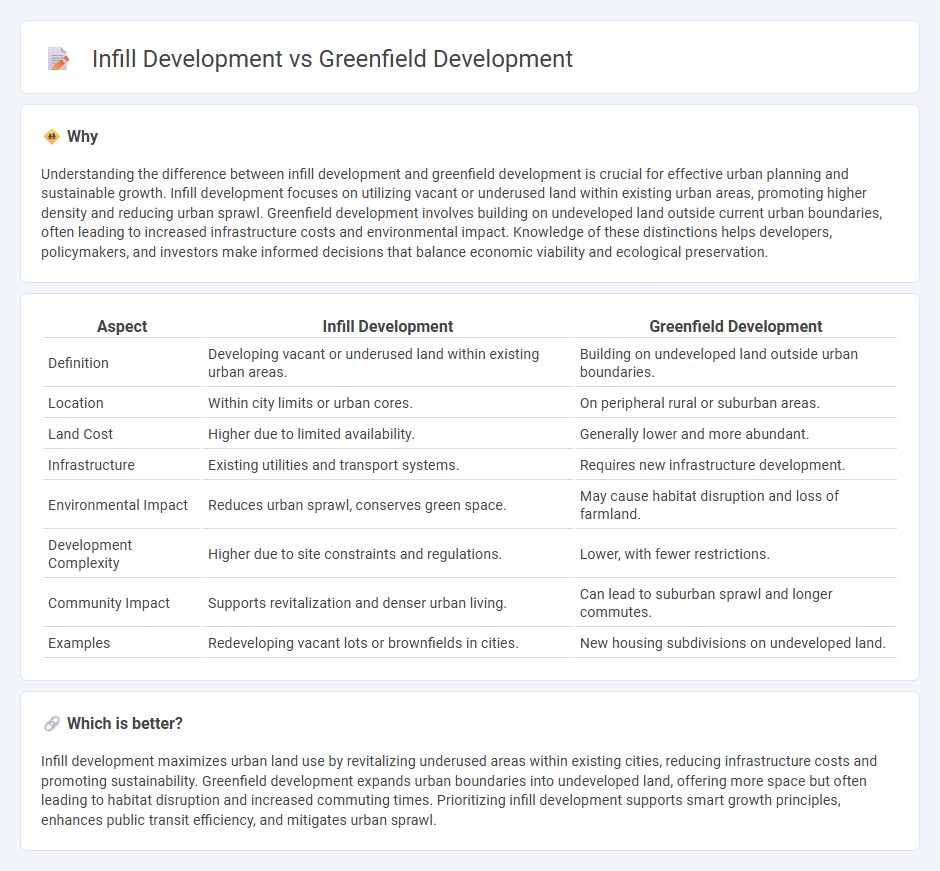
Infill development maximizes the potential of underutilized urban land, promoting sustainable growth by revitalizing existing neighborhoods and reducing urban sprawl. Greenfield development involves building on undeveloped land, typically at the outskirts of cities, offering opportunities for large-scale projects but often increasing infrastructure costs and environmental impact. Explore how these development strategies influence urban planning and investment decisions.
Why it is important
Understanding the difference between infill development and greenfield development is crucial for effective urban planning and sustainable growth. Infill development focuses on utilizing vacant or underused land within existing urban areas, promoting higher density and reducing urban sprawl. Greenfield development involves building on undeveloped land outside current urban boundaries, often leading to increased infrastructure costs and environmental impact. Knowledge of these distinctions helps developers, policymakers, and investors make informed decisions that balance economic viability and ecological preservation.
Comparison Table
| Aspect | Infill Development | Greenfield Development |
|---|---|---|
| Definition | Developing vacant or underused land within existing urban areas. | Building on undeveloped land outside urban boundaries. |
| Location | Within city limits or urban cores. | On peripheral rural or suburban areas. |
| Land Cost | Higher due to limited availability. | Generally lower and more abundant. |
| Infrastructure | Existing utilities and transport systems. | Requires new infrastructure development. |
| Environmental Impact | Reduces urban sprawl, conserves green space. | May cause habitat disruption and loss of farmland. |
| Development Complexity | Higher due to site constraints and regulations. | Lower, with fewer restrictions. |
| Community Impact | Supports revitalization and denser urban living. | Can lead to suburban sprawl and longer commutes. |
| Examples | Redeveloping vacant lots or brownfields in cities. | New housing subdivisions on undeveloped land. |
Which is better?
Infill development maximizes urban land use by revitalizing underused areas within existing cities, reducing infrastructure costs and promoting sustainability. Greenfield development expands urban boundaries into undeveloped land, offering more space but often leading to habitat disruption and increased commuting times. Prioritizing infill development supports smart growth principles, enhances public transit efficiency, and mitigates urban sprawl.
Connection
Infill development and greenfield development are interconnected real estate strategies addressing urban growth by optimizing land use; infill focuses on developing vacant or underused parcels within existing urban areas, enhancing community density and infrastructure efficiency. Greenfield development involves building on previously undeveloped land, often at the urban periphery, offering opportunities for new housing and commercial projects but potentially increasing sprawl and infrastructure demands. Balancing both approaches supports sustainable urban expansion by preserving natural landscapes through infill while accommodating growth needs via greenfield sites.
Key Terms
Land Use
Greenfield development involves constructing on previously undeveloped land, often at urban fringes, leading to new land use patterns and potential environmental impacts. Infill development focuses on utilizing underused or vacant parcels within existing urban areas, promoting efficient land use and reducing urban sprawl. Explore more about how these approaches affect sustainable land management and urban growth strategies.
Infrastructure
Greenfield development entails constructing infrastructure on previously undeveloped land, offering flexibility for modern design but often requiring extensive new utility networks and transportation systems. In contrast, infill development involves upgrading and integrating infrastructure within existing urban areas, optimizing current utilities and reducing the need for significant new installations. Explore the advantages and challenges of each approach to infrastructure planning for sustainable urban growth.
Zoning
Greenfield development involves constructing new projects on previously undeveloped land, often requiring extensive zoning changes to accommodate residential, commercial, or industrial uses. Infill development targets vacant or underused parcels within existing urban areas with established zoning, sometimes necessitating zoning variances or updates to enhance density or mixed-use characteristics. Explore further to understand how zoning frameworks impact sustainable urban growth strategies.
Source and External Links
A Guide to Greenfield Development - Discusses the concept of greenfield development, highlighting its benefits and challenges compared to brownfield development.
What Is Greenfield Development? - Explains greenfield development as real estate development on previously undeveloped land, including natural open areas like grasslands and forests.
Greenfield Opportunity & Renewable Energy Development - Describes greenfield opportunities in the context of renewable energy development, focusing on flexibility and innovation.
 dowidth.com
dowidth.com